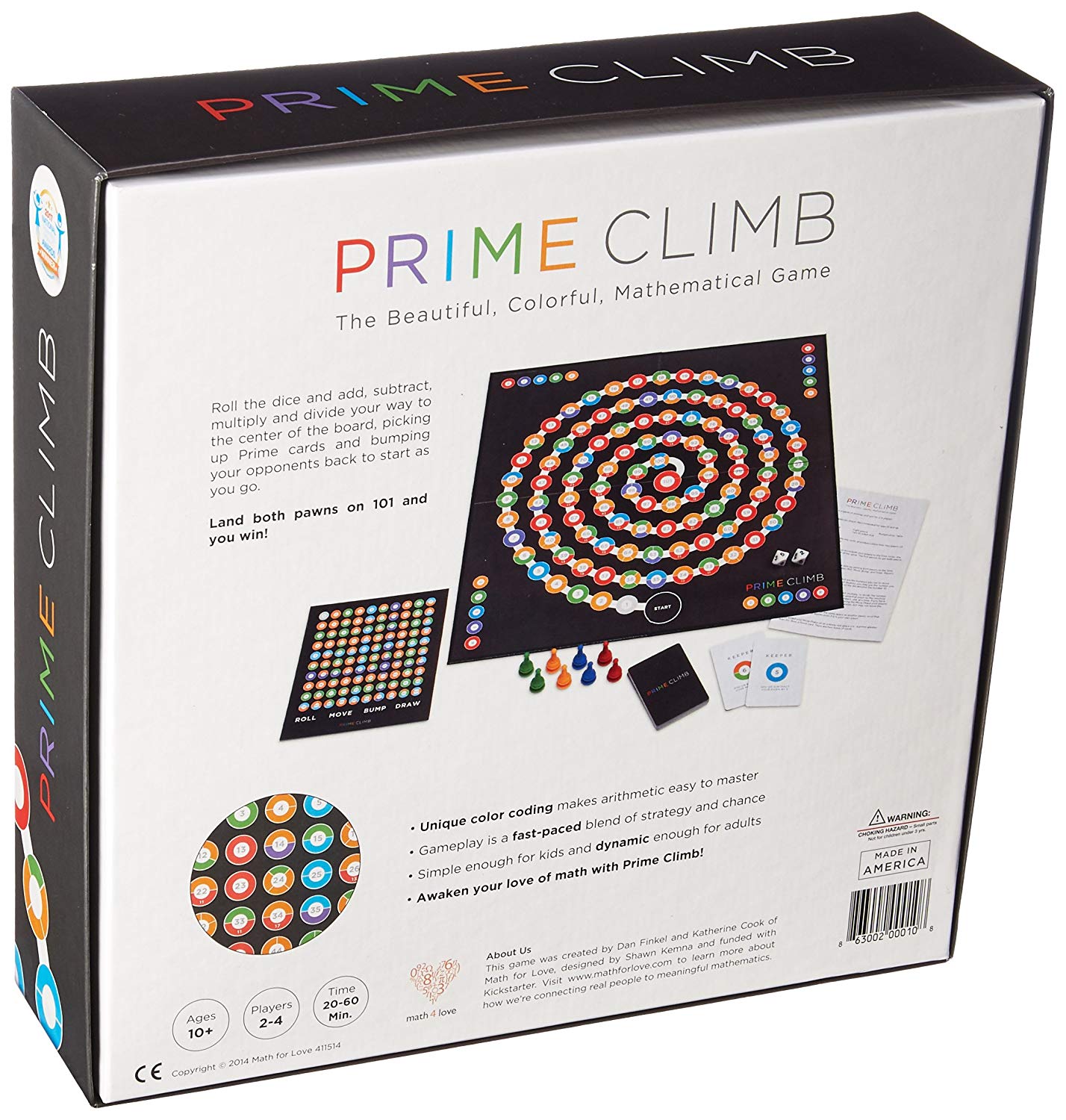Math for Love : Prime Climb - The Beautiful Colourful Mathematical Board Game, 10+ years
,gravity=Center,allowExpansion)
,gravity=Center,allowExpansion)
,gravity=Center,allowExpansion)
,gravity=Center,allowExpansion)
Collect 59 Everyday Rewards points
Dispatch in 2 business days
,gravity=Center,allowExpansion)
,gravity=Center,allowExpansion)
,gravity=Center,allowExpansion)
,gravity=Center,allowExpansion)
Collect 59 Everyday Rewards points
Dispatch in 2 business days
THE BEAUTIFUL MATHEMATICAL COLORFUL GAME
Prime Climb is a game of strategy and luck for 2-4 players.
Time: Roughly 10 minutes per player. Recommended for ages 10 and up.
In the Box:
Prime Climb board
24 Prime cards + four blank cards
Multiplication table reference sheet
Two 10-sided dice
Eight pawns
Instructions
SETUP
Lay out the board, shuffle the cards, place two pawns on Start for each player, and roll the dice to decide who will play first. You're ready to go!
GOAL OF THE GAME
See the 101 circle? It's the big red circle at the center of the spiral. The goal of Prime Climb is to land both your pawns on 101 exactly.
RULES
Players take turns until someone wins by landing both pawns exactly on the 101 circle. You are never allowed to move a pawn past 101. All players begin the game with both pawns at the Start circle, which counts as 0.
A turn consists of four phases: Roll, Move, Bump, and Draw.
1. Roll
Roll the dice. The two numbers you roll will be used, one at a time, to move your pawns. In other words, if you roll a 3 and a 5, you have a 3 and a 5 to use on your turn; you do not get to use an 8, a 15, or a 35.
In the case of doubles, you may use the number you rolled four times instead of twice. The "0" on the dice stands for "10." You must use all your rolls.
2. Move
During your Move Phase, you add, subtract, multiply, or divide the number your pawn is on by a number you rolled and send that pawn to the resulting number. You must use all of your rolled numbers, one at a time. If you have Keeper cards, you may choose to play one or more of them before, between, or after applying your dice rolls. Your pawns may land on any space on the board, including occupied spaces. Pawns may never move to a space not on the board, such as negative numbers, non-whole numbers, or numbers greater than 101.
Example. Say you have a pawn on 14, and you roll a 3 and a 9. You could, if you chose, subtract 3 from 14 to land on 11, then multiply 11 by 9 to move to 99. Note that each die is applied one at a time. You cannot multiply 3 times 9 and use 27 for your move.
For more details, see the examples further on in these rules.
3. Bump
If you end your Move Phase with either of your pawns on the same space as another pawn, send the pawn you landed on back to Start. Bumping is not optional.
Note: You can bump your own pawns.
Note: You bump a pawn only when you end your turn on an occupied space, not when you pass through an occupied space.
Example. You have a pawn on 31. Your opponents have pawns on 33 and 37. You roll a 2 and a 4, which you apply by adding the 2 to move from 31 to 33, and then adding the 4 to move from 33 to 37. You bump the pawn on 37 back to Start. You do not bump the pawn on 33 back to Start, since you did not end your Move Phase on 33.
4. Draw
You draw a Prime Card after your Move and Bump Phases are completed if
a) At least one of your pawns is on an entirely red space (i.e., a prime number greater than 10), and
b) That pawn did not begin its turn on that space.
You may draw only one card per turn, even if both your pawns end on red spaces. No card trading is allowed!
There are two types of Prime cards:
After you play a card, discard it. If you run out of cards, shuffle the discard pile and continue drawing as necessary.
101 AND WINNING THE GAME
When your first pawn reaches the 101 circle exactly, remove it from the board. You cannot move to a number past 101, or "bounce off" 101.
Example. You want to apply a roll of 7 to pawn on 98. You cannot roll to 101 by adding, and cannot roll forward 3 and back 4 to end at 97. The only options available are to subtract to end at 91, or divide to end at 14.
After your first pawn reaches 101, you must apply all dice rolls to your remaining pawn. You win immediately when you can apply a die roll or Keeper card to land your second pawn on 101. You do not have to use both die rolls on your winning move.
Do not draw a Prime Card when you land on 101.
EXAMPLES
Example 1.
With pawns on 4 and 26, you roll a 3 and a 9. You could:
GTIN: 863002000108
Estimated Delivery Time Frame:2-7 business days
Ask a Question About This Product
Reference ID: 1242519